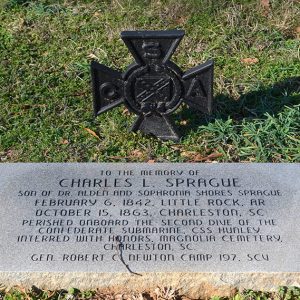calsfoundation@cals.org
Charles Leslie Sprague (1842–1863)
Charles Leslie Sprague was a Little Rock (Pulaski County) native who died while serving on the crew in a test run of the Confederate naval H.L. Hunley, the first combat submarine to sink an enemy warship.
Charles Leslie Sprague was born in Little Rock on February 6, 1842, the youngest of four sons of Dr. Alden Sprague and Sophronia Stores Eldridge Sprague. Alden Sprague died on April 26, 1847, and Charles and his mother moved back to her native New Hampshire to live with her sister, Lucinda Eldridge Billings, and her family. Sophronia Sprague died on December 5, 1853, and it is possible that young Charles moved to Tennessee to live with relatives, as her brother lived there.
Charles enlisted in his cousin’s Confederate artillery battery after the Civil War broke out. Charles Sprague joined Captain John W. Eldridge’s Company of Light Artillery on May 20, 1862, at Corinth, Mississippi, which would become J. W. Mebane’s battery after Eldridge was removed from command during a reorganization. Sprague’s service records are divided into two groups, the first listing him as C. L. Sprague and ending with the notation “knows something about torpedoes.”
In April 1863, Sprague was ordered to report to the District of the Gulf “for the purpose of constructing ‘plan and models’ of a ‘Self placing Torpedo & Fire Boat.” Sprague developed the plans at Jackson, Mississippi, but was “compelled by the appearance of the enemy at that place on or about the 15th day of May to destroy his plans,” Mebane wrote in a report. “He now desires to proceed to the ‘Coast’ to reconstruct his ‘Plans & Models.’” In August 1863, Sprague was ordered for service as a “Torpedo boatman” in Charleston, South Carolina, where a submarine built by Horace Hunley and his partners had been sent after undergoing successful trials in Mobile, Alabama. A letter in Sprague’s file says the young man was “here for the purpose of Examining the ‘Torpedo Boat’…to ascertain if a device suggested by him for attaching torpedos [sic] to several vessels in succession to Explode by clock work nearly Simultaneously may not be successfully applied.”
The vessel—referred to as the “fish boat,” “fish torpedo boat,” or “porpoise”—was placed under the command of the Confederate military after arriving in Charleston and manned with a crew primarily made up of volunteers from Confederate naval vessels; Sprague was attached to the crew of the unnamed submarine as its explosives expert. The ship was making a practice run in Charleston Harbor on August 29, 1863, when it accidentally dove with its hatches open; Sprague and three others escaped, but five crewmen died. The submarine was raised and began making practice sorties with a new crew and Sprague, the only member of the original crew to remain with the ship.
On the morning of October 15, 1863, the vessel set out into Charleston Harbor under the command of Horace Hunley in the absence of its normal commander. Hunley apparently erred in regulating the amount of water in the forward ballast tank, causing the vessel’s bow to bury itself in the mud. The ship partially filled with water, and its crew, including Hunley and Sprague, either drowned or asphyxiated. All were buried in Charleston’s Magnolia Cemetery, along with the dead of the earlier accident, and the submarine was named H.L. Hunley in honor of its inventor. Several months later, on February 17, 1864, the Hunley attacked the USS Housatonic with an explosive device attached to a spar protruding from the submarine’s bow. The U.S. warship sank, and the Hunley and its crew were also lost. The Hunley was located in 1995 and raised; the submarine can now be viewed in the Warren Lasch Conservation Center in North Charleston, South Carolina.
On April 7, 2018, the General Robert C. Newton Camp 197, Sons of Confederate Veterans, placed a memorial stone to Charles Sprague in Little Rock’s Mount Holly Cemetery, where the sailor’s father is buried.
For additional information:
Campbell, R. Thomas. The CSS H.L. Hunley: Confederate Submarine. Shippensburg, PA: Burd Street Press, 2000.
Neyland, Robert S., and Heather G. Brown. H.L. Hunley Recovery Operations. Washington DC: Naval History and Heritage Command, 2016. Online at https://www.history.navy.mil/content/dam/nhhc/research/underwater-archaeology/PDF/HLHunley_RecoveryOperations_20161123_FINAL_20170216.pdf (accessed July 13, 2018).
Wills, Rich. “H.L. Hunley in Historical Context.” National Underwater and Marine Agency. http://www.numa.net/expeditions/hunley-c-s-s/ (accessed July 13, 2018).
Mark K. Christ
Little Rock, Arkansas







Comments
No comments on this entry yet.